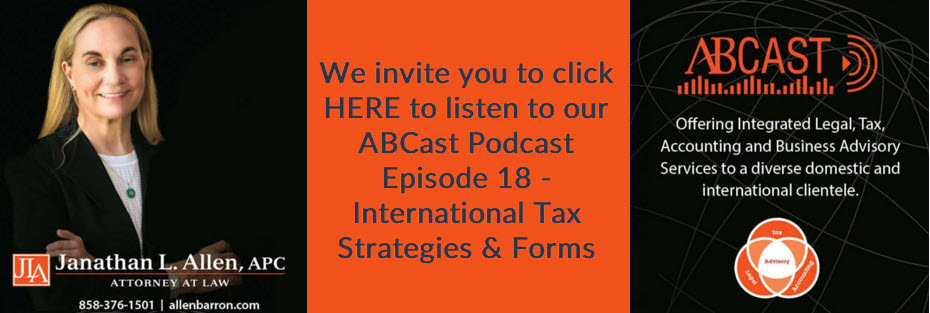Common Forms Associated with Foreign Asset and Income Reporting to the IRS
We continue with Part 2 – International Tax Primer for US Taxpayers and Expatriates with one of the most common forms associated with foreign asset and income reporting to the IRS: Form 8938, the Statement of Specified Foreign Financial Assets.
 There is often a lot of confusion associated with IRS Form 8938 and the FBAR / FinCEN Form 114. Many US taxpayers have come to understand the FBAR / FinCEN Form 114, which is the form used by US taxpayers to disclose foreign assets such as bank accounts, insurance policies and mutual investments.
There is often a lot of confusion associated with IRS Form 8938 and the FBAR / FinCEN Form 114. Many US taxpayers have come to understand the FBAR / FinCEN Form 114, which is the form used by US taxpayers to disclose foreign assets such as bank accounts, insurance policies and mutual investments.
The IRS Form 8938 has a lot in common with the type of information provided on an FBAR, however, the FBAR is transmitted to the Department of Justice, where the IRS Form 8938 is provided directly to the IRS (Treasury Department). This is the distinction, while the information may be the same, the distribution of the forms is going to two different US agencies.
The FBAR threshold is if you have accumulation of accounts, savings accounts, et cetera, in excess of $10,000, you’re required to report those on the FBAR / FinCEN Form 114, IRS Form 8938 has a different reporting limit. The requirement to file Form 8938 is dependent on whether or not you’re married or single. The limit is $75,000 for a single individual and $150,000 for a married couple.
Form 8938 expands the types of assets that are required to be reported to include, for example, foreign pensions, foreign insurance, think of social security in a foreign country, things of that nature that are not included on the FBAR because of the liquidity, the difference in liquidity.
There is also IRS Form 8621 – Information Return by a Shareholder of a Passive Foreign Investment Company or Qualifying Fund. The IRS Form 8621 basically reports the investment in, for example, a foreign mutual company.
The great challenge for a US taxpayer is this: foreign mutual companies and the assets themselves are not reported overseas the way they are here in the US.
If you think about a Form 1099 that you would receive at year’s end for a US investment, those end of year (1099) statements will have a breakout of interest dividends earned, if any, on the assets that are held by that institution as well as associated capital gains and losses. This is due to the fact that the United States goes back and taxes, gains and losses, interest and dividends on a yearly basis.
Offshore and foreign investment reporting (such as in Europe) are quite different and do not provide the type of information required for a US tax return. In Europe and most other countries, the capital gains and losses are not reported until the associated asset is actually sold. Therefore, the distinction between the US and the rest of the world is how and when it is that the US taxes gains – realized or unrealized.
In cases associated with foreign mutual fund investment, your tax professional must reconstruct offshore transactional information provided by foreign mutual investments in order to conform to US tax reporting requirements. This requires extensive research and analysis and adds a substantial cost to not only the preparation of a US tax return, but impacts the resulting tax exposures associated with capital gains (and losses) which the US taxpayer may not have yet realized in their offshore mutual fund account.
Common Tax-Related Challenges for US Expatriates
Part 2 – International Tax Primer for US Taxpayers and Expatriates provides specific insights for US expats. What are some of the common challenges that a US expatriate faces and what do they need to know about continuing US tax reporting requirements and exposures?
 When a US taxpayer leaves the United States, their obligation to file a tax return has not abated. Perhaps the US person has left the United States and moved for a job, marriage, travel or any other reason. They are still required to file a US tax return. It is a mistake to presume that simply because one is outside of the US and earning foreign income, the US expatriate is not required to file a tax return. US persons, including expatriates, are required to file a tax return, even if their income is zero, or less than the present Foreign Earned Income Exclusion (FEIE).
When a US taxpayer leaves the United States, their obligation to file a tax return has not abated. Perhaps the US person has left the United States and moved for a job, marriage, travel or any other reason. They are still required to file a US tax return. It is a mistake to presume that simply because one is outside of the US and earning foreign income, the US expatriate is not required to file a tax return. US persons, including expatriates, are required to file a tax return, even if their income is zero, or less than the present Foreign Earned Income Exclusion (FEIE).
It is important to note that it is always important to file a tax return. The IRS statute of limitations is based upon the filing date of any return. If one does not file a tax return, the IRS has no statute of limitations on look-back tax exposures or associated penalties and interest.
Perhaps one of the most important tax issues for US expatriates is the requirement to report offshore bank accounts, pensions, investments, cryptocurrency and real estate. The Foreign Bank Account Report or FBAR / FinCEN Form 114 is required if the total balance in any of your accounts or the sum of all accounts exceeds $10,000 at any point in a tax year, even if only for a minute, or an hour. Your FBAR / FinCEN Form 114 is due on the same date as your federal tax return.
There are a couple of strategies associated with the reporting of foreign earned income when you are an expat. The Foreign Earned Income Exclusion (FEIE) allows for a certain amount of income to be excluded from your US income tax return.
In most instances the FEIE eliminates the issue of double taxation. For example, if a US person is living and earning income in the UK that income would be reported on their US tax return. The application of the Foreign Earned Income Exclusion (FEIE) would, in effect, eliminate most of that income so that there is no tax due on the US tax return for that expat.
If this is your first time filing as a US expatriate, it is important to know that you must qualify for and elect to take FEIE by using IRS Form 2555. Once the FEIE election is made it remains in effect until it is rescinded by the US expat. This is not an “on/off” decision as once it is rescinded you may not be able to elect to use it again for 5 years without the consent of the IRS.
The other strategy to mitigate the issue of double taxation when a US person is earning income in a foreign country is the utilization of the foreign income tax that’s paid in the country of residence against your US income tax obligation. The US tax code provides this “Foreign Tax Credit” and it can bel claimed and applied through IRS Form 1116.
In this example, a US expat living in a high tax rate country (i.e. most anywhere in Europe) their individual income tax rates are generally far higher than those here in the United States. When the residential country’s tax rate is higher than the US it is usually wise to apply the tax paid in that residential country’s tax return as a credit against your US taxable income. In this example the US expat would not have to pay any US income tax on that foreign income.
US Expats with children (US dependents) may be able to deduct childcare expenses and take advantage of the Child Tax Credit to reduce overall expatriate tax exposure. The dependent(s) must have a US Social Security Number. Note: if the US expatriate in this example have excluded income under FEIE they may not be able to apply the Child Tax Credit.
If the US expat retains real property in the US or owns real estate abroad any and all rental income from all sources in the US and offshore must be reported on your US tax return. Obviously, keep all records associated with improvements, repairs and losses to review with your tax professional. These may be used to offset present income or impact future gains if a property is sold.
Passive Foreign Investment Company or PFIC Taxation (Foreign Mutual Funds)
Another common international tax issue is associated with what is known as a Passive Foreign Investment Company or PFIC. What investments are considered to be a PFIC and what does a US taxpayer need to understand about PFIC type investments?
PFIC type investments can occur in a couple of situations. Perhaps the most common type of PFIC investment would be ownership of foreign mutual funds. Foreign mutual funds are by definition PFIC entities because they hold investments for investment purposes. In other words, for passive purposes, not for active ongoing operations.
So when most US taxpayers expose themselves to a PFIC computation, it’s in relation to a foreign mutual fund. However, if an individual has ownership in a foreign corporation, that foreign corporation, if it has savings and it’s earning interest on that savings account, that investment could be a PFIC computation relating to the passive investment that is being earned by that corporation that is wholly unrelated to its overall day to day operations.
So the PFIC calculation can inure in a couple of ways, but it’s important that a US person or taxpayer understand the potential for filing requirements based on the passive investment, either outright in a mutual fund or within an entity in which they may have ownership in as well.
How does PFIC taxation compare to any other form of international investment?
 The PFIC computation is based upon how income is earned overseas and recasting it in the way that we report it here in the United States. The PFIC computation really forces US persons and their tax professionals to do the computation that the foreign financial institutions and banks haven’t done because they don’t report transactional information in Europe or the rest of the world the way we report it here in the United States.
The PFIC computation is based upon how income is earned overseas and recasting it in the way that we report it here in the United States. The PFIC computation really forces US persons and their tax professionals to do the computation that the foreign financial institutions and banks haven’t done because they don’t report transactional information in Europe or the rest of the world the way we report it here in the United States.
This requires your tax professional to recreate the transactional data in order to compute what the interest is, what the dividends are, and more importantly, the gain or the loss on every individual transaction that a particular PFIC entity may hold. This is a very complicated and time-consuming task. It is quite expensive for individuals that are unaware of the types of PFIC investments hold and the tax ramifications they may incur here in the United States as a result of specific international holdings.
Your investment in a foreign corporation or mutual fund will be taxed as a PFIC if more than 75% of the gross income for its taxable year is considered by the IRS to be passive income, or if 50% or more of the assets held by that foreign corporation or mutual fund either produced passive income or were held for the purpose of producing passive income.
The net result is that the US tax rate on PFIC investment income can exceed 50% for many US taxpayers.
Foreign Real Estate
While, relatively speaking, foreign real estate is taxed fairly similarly to the way that it is here in the United States, depreciation’s a different matter altogether. Fortunately for US taxpayers the depreciation that’s allowed on foreign property is the same as it is here in the States.
The interesting thing, however, is while other foreign countries may not tax the sale of that property, the United States will. It’s not the property itself that they’re taxing, it is the individuals who own the property that are being taxed. So it is a far more complex issue than many people normally think of, particularly if they’re US bound and going outside of the United States, then perhaps it is for foreigners that are coming to the United States and become residents and then subsequently citizens.
Transactional Planning
As we conclude this conversation in Part 2 – International Tax Primer for US Taxpayers and Expatriates about reporting of foreign assets for US persons and the taxes associated with foreign reporting, the conversation with your financial and tax professional should include transactional planning. How should a US taxpayer approach foreign offshore tax planning and transactional planning?
 The primary goal of transactional planning is to protect one’s assets and interests while structuring their portfolio to reduce or eliminate risk and minimize tax exposures here in the United States and around the world. The other primary concept associated with transactional planning is to carefully assess how income is earned worldwide, as well as where income is realized and when.
The primary goal of transactional planning is to protect one’s assets and interests while structuring their portfolio to reduce or eliminate risk and minimize tax exposures here in the United States and around the world. The other primary concept associated with transactional planning is to carefully assess how income is earned worldwide, as well as where income is realized and when.
It isn’t possible to do a comprehensive transactional plan without taking a look at the overall assets that an individual has, and that includes bank accounts and investments, and it may be real estate here in the United States as well as real estate, foreign investments and corporate ownership outside of the United States.
Many people seem to be quite comfortable going with a financial planner, but the financial planner doesn’t necessarily put together the entity holdings and the structural transactions by and between entities with which to create operational or investment or active income so that it minimizes and/or mitigates risk while it minimizes associated taxation.
Transactional planning is a crucial step regardless if a US taxpayer’s assets are all held domestically, if they’re held domestically and internationally, or if they’re all international in nature. Your transactional plan can help individuals do the two things that I think most everybody in the world are looking to do: mitigate risk and minimize tax.
Transactional planning is an exercise which integrates a variety of important professional skills: tax, legal, and accounting.
Basically there’s a two-pronged strategy here. One is how the corporate entity itself or the constellation of corporations is structured and then how, where and when the holdings realize income and therefore generate tax exposure.
We’ve discussed a lot of the “how” offshore income is realized, but a conversation on transactional planning would not be complete without a discussion of “where” income is realized or “when.” The “where” aspect of transactional planning is based upon international corporate tax rates and associated income tax. It may provide an advantage to structure an entity in Ireland, for example, where the corporate tax rate is one of the lowest in the world.
When should you realize gains or losses? Many US taxpayers work on a calendar tax year basis and when entities are structured around a calendar tax year there it is very hard to impact the timing of the realization of income or losses. A C Corporation is an entity that can provide the ability to establish a fiscal tax year (i.e. April 1 through March 31). The utilization of a C Corporation could provide the valuable ability to defer income and/or losses from the Calendar year of the US taxpayer as an individual to the fiscal year of the C Corporation.
Simply put, any income or losses which can be deferred from December of a given tax year for an individual filer into the following calendar year (such as January of the next year) defer the resulting net payment of taxes owed upon income for an entire year. In the same manner, if one has experienced substantial earnings it may be appropriate to accelerate losses into the current calendar year to offset income. The C Corporation is one example of a transactional planning which allows the US taxpayer to accelerate or decelerate income or losses within a calendar tax year depending upon what is best from a tax point of view.
Allen Barron Inc. and Janathan L. Allen, APC
 Clients of Allen Barron Inc. and Janathan L. Allen, APC value the integrated tax, legal, accounting and business consulting services of a single provider. In a typical situation for a US taxpayer with international holdings, the taxpayer would need to consult the services of multiple providers: an attorney, a CPA or Tax Professional, a Business Advisor and a separate bookkeeping/accounting source.
Clients of Allen Barron Inc. and Janathan L. Allen, APC value the integrated tax, legal, accounting and business consulting services of a single provider. In a typical situation for a US taxpayer with international holdings, the taxpayer would need to consult the services of multiple providers: an attorney, a CPA or Tax Professional, a Business Advisor and a separate bookkeeping/accounting source.
The inherent problem in the multiple expert scenario is simple: each professional can only look at the situation from their specific point of view. The attorney is focused on entities and contracts as well as the protection of assets.
The CPA or Tax Professional is focused upon the issues of balancing income and losses to effectively minimize tax exposure and the bookkeeper is focused upon recording transactions in their own way without regard to how the structure and accounting of specific transactions (and the entities associated with those transactions) will substantially impact resulting taxation.
The integration of tax, legal, accounting and business advisory services in a single source provider allows Allen Barron Inc. and Janathan L. Allen, APC to look at the scenario from the perspective of the “whole.” In many cases what may appear to be the best legal solution may actually result in greater expenses and an increased tax liability. Tax professionals cannot structure legal entities and protections to preserve the assets you’ve worked so hard to build. Not one of the single professionals can look at the situation of an international or blended (domestic and international) portfolio and provide the transactional planning required to protect the assets at hand and minimize or eliminate risk while reducing tax exposure.
We invite you to contact us or call 1-866-631-3470 to schedule a comprehensive free consultation with Janathan Allen and the professionals of Allen Barron.






